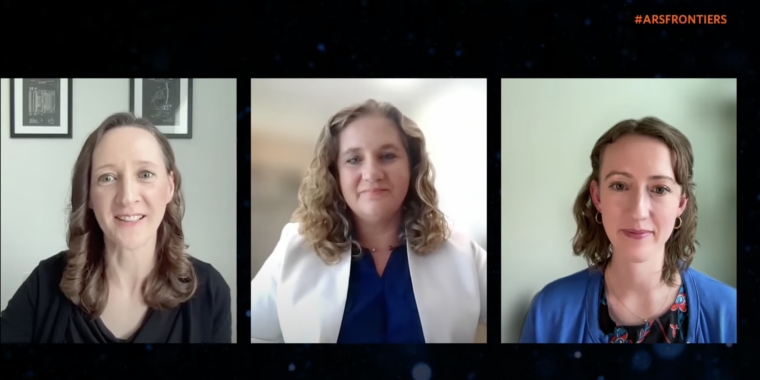Our panel on pandemic lessons included Dr. Jennifer Nuzzo (center) and Dr. Caitlin Rivers (right).
In many ways, modern developments have stolen the show during the COVID-19 pandemic. With unprecedented speed, researchers have decoded and shared the genetic blueprints of SARS-CoV-2. They developed highly effective, safe vaccines and treatments. Near real-time epidemiological data was at our fingertips and global genetic surveillance for viral variants reached unparalleled heights.
But while the wonders of modern medicine and biotechnology made an impression, the US struggled with the basics. Health departments were chronically underfunded and understaffed. Behind slick COVID-19 dashboards, healthcare workers shared data in basic spreadsheets via email and even fax machines. Long-standing deficiencies in primary care have deepened health inequalities. And helpful pandemic prevention tools like masks have been maligned in the divide between communities and local health departments.
At our Ars Frontiers conference this year, I virtually sat down with two leading experts on pandemic preparedness, who discussed these takeaways from the COVID-19 pandemic. I spoke with: Dr. Jennifer Nuzzo, the director of the Pandemic Center and a professor of epidemiology at Brown University’s School of Public Health, and Dr. Caitlin Rivers, a senior researcher at the Johns Hopkins Center for Health Security and cofounder of the Center for Forecasting and Outbreak Analytics at the Centers for Disease Control and Prevention.
More health workers
The conversation started with a general question from Nuzzo about how we were doing overall with COVID-19. She discussed some of the highlights: we all became familiar with pandemic tools, which will be useful in the future; we initiated real-time data collection, setting the bar for the next pandemic; and we’ve packed health departments with contractors.
But this last point was also a concern because the staff hired during the pandemic were brought in with emergency funding — and those positions were cut when the emergency funding did.
“This is something I’m really, really concerned about, probably, maybe most of all,” Nuzzo said. “If you remember three years ago when we started this pandemic, we were nowhere near the kind of public health infrastructure, the public health protections that we need in terms of people working in health departments to help us get through the data and tell us what we need to do to help us live healthier, safer lives… They are the infrastructure that should be in our communities to help us keep ourselves safe at all times.”
Better data infrastructure
While the state of the human-based infrastructure at the root of our response is a major issue, so is our data infrastructure, Rivers explains. With the public health emergency, the federal government empowered the CDC to compel states and jurisdictions to share COVID-19-related data, paving the way for near-real-time pandemic tracking at the national level. But without an emergency declaration, the service does not have that authority. And to get basic disease data from individual states and jurisdictions, the agency has to enter into individual legal agreements with each state and jurisdiction for each disease, resulting in non-standardized data.
“These are not blanket agreements,” Rivers explains. “They’re disease-specific about when and how and what data will flow. And as you can imagine, it takes weeks, if not months, to organize a single match. We’re talking hundreds of matches in all, and it’s a very slow process.” The burden of negotiating this “is one of the real challenges we have with our public health data infrastructure.”
Another is the anachronistic way health departments collect and share data – often in simple spreadsheets, shared via email or archaic fax machines.
“There’s a lot of manual data entry. There’s a lot of faxing. There’s a lot of emailing with spreadsheets. And if we could take some of that manpower back and use it for public health, to actually keep people healthier, that’s going to be a to be a huge win,” said Rivers.
While very optimistic about the new funding Congress has approved for data modernization, she noted that “if you start with fax machines, it’s going to be a long way back.”
Address inequalities and build trust
While our infrastructure needs updating, we could also do more to prepare the public to respond to pandemic threats, Nuzzo said. She noted an example of pandemic exercises in Taiwan where they have used mass vaccination of seasonal flu vaccines as an emergency vaccination practice. The drills help people know what to do and where to go, while officials can test how quickly they can roll out shots and reach high-risk populations like the elderly.
While the US was able to mount mass vaccinations, there were “deep disparities” in who knew where to go and what to do.
“I think one of the biggest lessons from this pandemic is that our underlying social vulnerabilities turned out to be our biggest pandemic vulnerabilities,” Nuzzo said, adding that it will take “community-based participation” and policies, such as paid sick leave, to overcome this. to deal with .
Building trust between health experts and communities, especially vulnerable communities, is critical to responding to the next threat, Nuzzo and Rivers noted.
“One of the things that the pandemic has really exposed is how much of a primary health care crisis we have in this country and that if people don’t have regular access to medicines so they can build those trusting relationships…I think we’ll having a hard time,” Nuzzo said.
Rivers made a similar point, noting that the pandemic responses lacked reliable, known sources of health information. “I’m not sure the public has ever had a chance to really get to know an epidemiologist or a public health official who could talk to them regularly, day in and day out, about what’s happening and what they should be doing,” he said. she. The next crisis, she said, needs a “warm face.”
Frame image by Ars Frontiers

